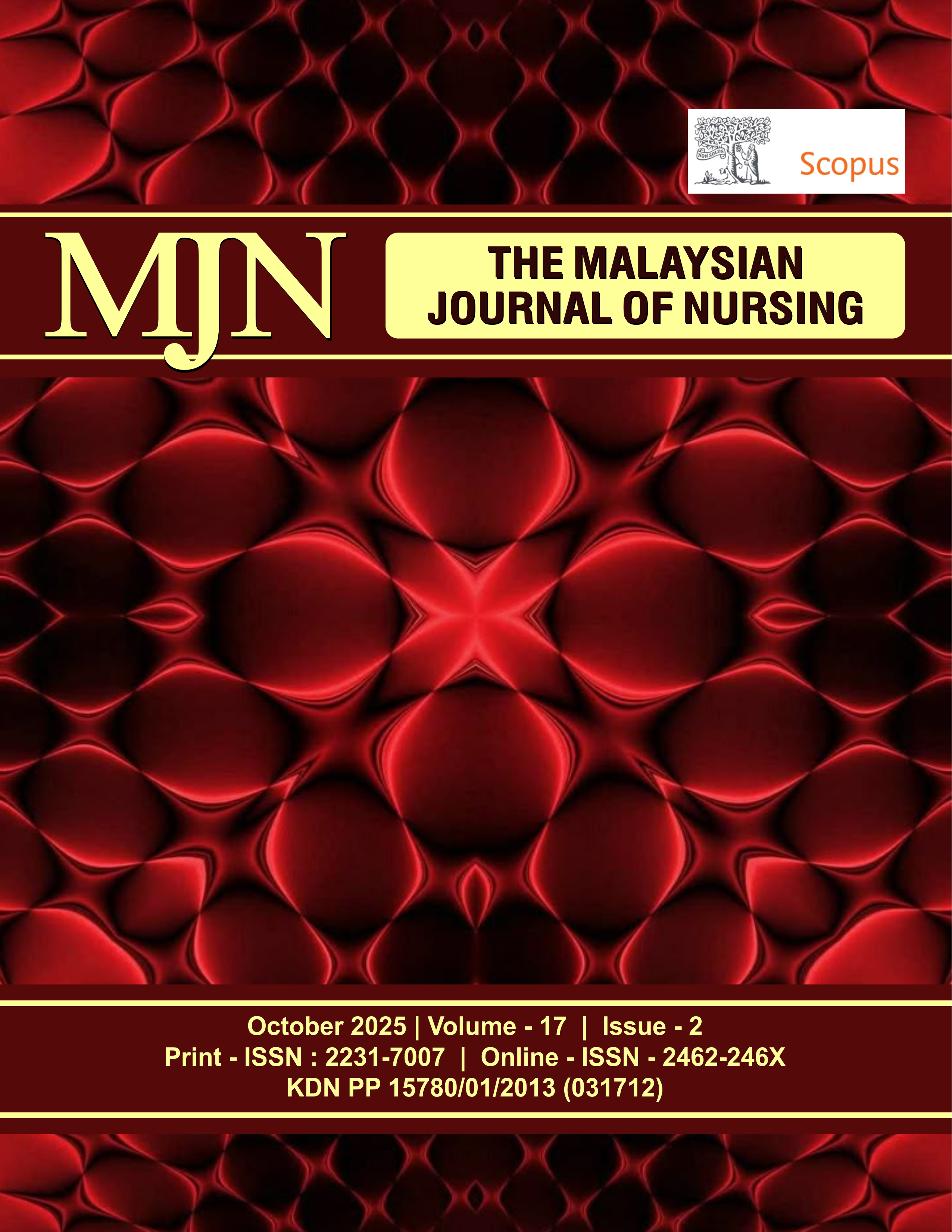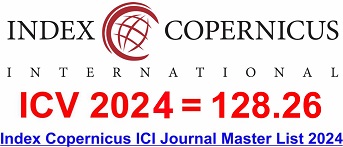Nursing Assessment Using Indonesian, Gordon, and NANDA-I Diagnosis Standards in Determining Nursing Problems: A Quasi-Experimental Study
DOI:
https://doi.org/10.31674/mjn.2025.v17i02.016Abstract
Background: Nursing assessment is a crucial initial step, and several formats are commonly used. Currently, the Indonesian National Nurses Association has directed all educational institutions to use SDKI, SLKI, and SIKI for nursing process. Objectives: This research aimed to compare nursing assessment using SDKI, Gordon, and NANDA-I (North American Nursing Diagnosis Association International) categorisation in determining nursing problems by nursing students. Methods: A Quasi-experimental non-equivalent control group post-test-only design was used. A total of 88 nursing students divided into three groups using simple random sampling. The instruments used were the ability to analyse nursing problems with content validity index analysis by five experts, and nursing problem analysis with Fleiss' Kappa. Results: The results showed the ability to analyse problems had a mean value of 3.15, while SDKI, Gordon, and NANDA-I had values of 3.13, 3.13, and 3.17 respectively. The mean rank value obtained was 47.53, 44.82, 41.14 (p-value: 0.632). Furthermore, the post-hoc test using pairwise comparison Kruskal Wallis test showed that the mean difference was as follows SDKI - Gordon group was 62.64 (SD: 8.96, p-value: 0.710), SDKI – NANDA-I was 62.95 (SD: 11.31, p-value: 0.322), and Gordon – NANDA-I was 62.97 (SD: 12.53, p-value: 0.606). Conclusion: Nursing assessment using the SDKI, NANDA-I, and Gordon 11 Functional Health Patterns did not have a significant difference. However, the observation results showed that SDKI had accuracy, precision, and ease in determining nursing problems. Recommendation: This nursing assessment might use for education and hospitals in using assessments based on the SDKI format to provide work efficiency in enforcing nursing problems.
Keywords:
Nursing Assessment, Nursing Diagnosis, Nursing Problems, SDKIDownloads
References
Aleandri, M., Scalorbi, S., & Pirazzini, M. C. (2022). Electronic nursing care plans through the use of NANDA, NOC, and NIC taxonomies in community setting: A descriptive study in northern Italy. International Journal of Nursing Knowledge, 33(1), 72–80. https://doi.org/10.1111/2047-3095.12326
Allen, E., Williams, A., Jennings, D., Stomski, N., Goucke, R., Toye, C., ... & McCullough, K. (2018). Revisiting the pain resource nurse role in sustaining evidence‐based practice changes for pain assessment and management. Worldviews on Evidence‐Based Nursing, 15(5), 368-376. https://doi.org/10.1111/wvn.12318
Asmirajanti, M., Hamid, A. Y. S., & Hariyati, Rr. T. S. (2019). Nursing care activities based on documentation. BMC Nursing, 18(S1), 32. https://doi.org/10.1186/s12912-019-0352-0
Asosiasi Institusi Pendidikan Ners Indonesia. (2021). Kurikulum Pendidikan Ners Indonesia Tahun 2021 [Indonesian Nursing Education Curriculum 2021]. AIPNI. https://repository.umj.ac.id/11480/1/buku%20kurikulum%20pendidikan%20Ners%20thn%202021%20edit%2023%20maret%202022_siap%20cetak.pdf
Bail, K., Merrick, E., Bridge, C., & Redley, B. (2020). Documenting patient risk and nursing interventions: Record audit. The Australian Journal of Advanced Nursing, 38(1), 36-44. https://doi.org/10.37464/2020.381.167
Bertocchi, L., Dante, A., La Cerra, C., Masotta, V., Marcotullio, A., Caponnetto, V., ... & Petrucci, C. (2024). Nursing diagnosis accuracy in nursing education: clinical decision support system compared with paper-based documentation—a before and after study. CIN: Computers, Informatics, Nursing, 42(1), 44-52. https://doi.org/10.1097/CIN.0000000000001066
Burdeu, G., Lowe, G., Rasmussen, B., & Considine, J. (2021). Clinical cues used by nurses to recognize changes in patients’ clinical states: A systematic review. Nursing & Health Sciences, 23(1), 9–28. https://doi.org/10.1111/nhs.12778
Butcher, R. D. C. G. E. S., Guandalini, L. S., De Barros, A. L. B. L., Damiani, B. B., & Jones, D. A. (2024). Psychometric evaluation of the functional health pattern assessment screening tool – modified Brazilian Version. Revista Latino-Americana de Enfermagem, 32, e4119. https://doi.org/10.1590/1518-8345.6755.4119
Butcher, R. D. C. G. E. S., & Jones, D. A. (2021). An integrative review of comprehensive nursing assessment tools developed based on Gordon's Eleven Functional Health Patterns. International Journal of Nursing Knowledge, 32(4), 294-307. https://doi.org/10.1111/2047-3095.12321
Butler, C. (2018). Nurses’ experiences of managing patient deterioration following a post-registration education programme: A critical incident analysis study. Nurse Education in Practice, 28, 96–102. https://doi.org/10.1016/j.nepr.2017.10.014
De Groot, K., Triemstra, M., Paans, W., & Francke, A. L. (2019). Quality criteria, instruments, and requirements for nursing documentation: A systematic review of systematic reviews. Journal of Advanced Nursing, 75(7), 1379–1393. https://doi.org/10.1111/jan.13919
Denny, M., Denieffe, S., & O’Sullivan, K. (2023). 15-Non-equivalent control group pretest–posttest design in social and behavioral research, The Cambridge Handbook of Research Methods and Statistics for the Social and Behavioral Sciences (1st ed., pp. 314–332). Cambridge University Press, UK. https://doi.org/10.1017/9781009010054.016
Edelman, C., & Kudzma, E. C. (2021). Health promotion throughout the life span-e-book. Elsevier Health Sciences.
Freire, V. E. C., Lopes, M. V. O., Keenan, G. M., & Lopez, K. D. (2018). Nursing students’ diagnostic accuracy using a computer-based clinical scenario simulation. Nurse Education Today, 71, 240–246. https://doi.org/10.1016/j.nedt.2018.10.001
Gasperini, B., Pelusi, G., Frascati, A., Sarti, D., Dolcini, F., Espinosa, E., & Prospero, E. (2021). Predictors of adverse outcomes using a multidimensional nursing assessment in an Italian community hospital. PLoS One, 16(4), e0249630. https://doi.org/10.1371/journal.pone.0249630
Gordon, M. (2014). Manual of nursing diagnosis (13th edition). Jones & Bartlett Learning, US.
Hariyati, Rr. T. S., Handiyani, H., Rahman, L. A., & Afriani, T. (2020). Description and validation of nursing diagnosis using electronic documentation: Study cases in mother and child hospital Indonesia. The Open Nursing Journal, 14(1), 300–308. https://doi.org/10.2174/1874434602014010300
Kamitsuru, S., Herdman, T. H., & Takáo Lopes, C. (2021). Future improvement of the NANDA-I terminology. Nursing Diagnoses. Definitions and Classification, 2023, 50-56. https://doi.org/10.1055/b000000515
Immonen, K., Oikarainen, A., Tomietto, M., Kääriäinen, M., Tuomikoski, A.-M., Kaučič, B. M., Filej, B., Riklikiene, O., Flores Vizcaya-Moreno, M., Perez-Cañaveras, R. M., De Raeve, P., & Mikkonen, K. (2019). Assessment of nursing students’ competence in clinical practice: A systematic review of reviews. International Journal of Nursing Studies, 100, 103414. https://doi.org/10.1016/j.ijnurstu.2019.103414
Iula, A., Ialungo, C., De Waure, C., Raponi, M., Burgazzoli, M., Zega, M., Galletti, C., & Damiani, G. (2020). Quality of care: Ecological study for the evaluation of completeness and accuracy in nursing assessment. International Journal of Environmental Research and Public Health, 17(9), 3259. https://doi.org/10.3390/ijerph17093259
Joseph, J., & Rotty, L. W. A. (2020). Kanker Paru: Laporan Kasus [Lung Cancer: A Case Report]. Medical Scope Journal, 2(1). https://doi.org/10.35790/msj.2.1.2020.31108
Kelsey, N. C., & Claus, S. (2016). Embedded, in situ simulation improves ability to rescue. [Embedded, in situ simulation improves ability to rescue]. Clinical Simulation in Nursing, 12(11), 522–527. https://doi.org/10.1016/j.ecns.2016.07.009
Kamblash, A. J., Jafari, M. J., Nemati-Vakilabad, R., Mojebi, M. R., Mostafazadeh, P., & Mirzaei, A. (2024). Nursing students’ competency about writing nursing care plan: an exploratory study in Iran. Journal of Nursing Management, 2024(1), 6653850. https://doi.org/10.1155/2024/6653850
Khatiban, M., Tohidi, S., & Shahdoust, M. (2019). The effects of applying an assessment form based on the health functional patterns on nursing student’s attitude and skills in developing the nursing process. International Journal of Nursing Sciences, 6(3), 329–333. https://doi.org/10.1016/j.ijnss.2019.06.004
Landis, J. R., & Koch, G. G. (1977). The measurement of observer agreement for categorical data. Biometrics, 33(1), 159–174. https://doi.org/10.2307/2529310
Lindo, J., Stennett, R., Stephenson‐Wilson, K., Barrett, K. A., Bunnaman, D., Anderson‐Johnson, P., Waugh‐Brown, V., & Wint, Y. (2016). An audit of nursing documentation at three public hospitals in Jamaica. Journal of Nursing Scholarship, 48(5), 499–507. https://doi.org/10.1111/jnu.12234
Lotfi, M., Zamanzadeh, V., Khodayari‐Zarnaq, R., & Mobasseri, K. (2021). Nursing process from theory to practice: Evidence from the implementation of “Coming back to existence caring model” in burn wards. Nursing Open, 8(5), 2794–2800. https://doi.org/10.1002/nop2.856
Miller, C. J., Smith, S. N., & Pugatch, M. (2020). Experimental and quasi-experimental designs in implementation research. Psychiatry Research, 283, 112452. https://doi.org/10.1016/j.psychres.2019.06.027
Müller-Staub, M., Needham, I., Odenbreit, M., Lavin, M. A., & van Achterberg, T. (2007). Improved quality of nursing documentation: Results of a nursing diagnoses, interventions, and outcomes implementation study. International Journal of Nursing Terminologies and Classifications, 18(1), 5–17. https://doi.org/10.1111/j.1744-618X.2007.00043.x
Paans, W., Sermeus, W., Nieweg, R. M., Krijnen, W. P., & Van Der Schans, C. P. (2012). Do knowledge, knowledge sources and reasoning skills affect the accuracy of nursing diagnoses? A randomised study. BMC Nursing, 11(1), 11. https://doi.org/10.1186/1472-6955-11-11
Palmer, R. M. (2018). The acute care for elders unit model of care. Geriatrics, 3(3), 59. https://doi.org/10.3390/geriatrics3030059
Park, J., & Jeong, S. (2022). The analysis of nursing diagnoses determined by students for patients in rehabilitation units. Journal of Exercise Rehabilitation, 18(5), 299–307. https://doi.org/10.12965/jer.2244336.168
Parvan, K., Hosseini, F. A., Jasemi, M., & Thomson, B. (2021). Attitude of nursing students following the implementation of comprehensive computer-based nursing process in medical surgical internship: A quasi-experimental study. BMC Medical Informatics and Decision Making, 21(1), 10. https://doi.org/10.1186/s12911-020-01378-6
Polit, D. F., & Beck, C. T. (2008). Nursing research: Generating and assessing evidence for nursing practice. Lippincott Williams & Wilkins, Philadelphia.
Polit, D. F., Beck, C. T., & Owen, S. V. (2007). Is the CVI an acceptable indicator of content validity? Appraisal and recommendations. Research in Nursing & Health, 30(4), 459–467. https://doi.org/10.1002/nur.20199
Purabdollah, M., Zamanzadeh, V., Ghahramanian, A., Valizadeh, L., Ghasempour, M., & Mousavi, S. (2025). Determining and comparing the achieved competencies of graduating nursing students of public and private universities in Iran. BMC Medical Education, 25(1), 25. https://doi.org/10.1186/s12909-024-06622-5
Reis, G. A. X. D., Matsuda, L. M., Souza, V. S. D., Ferreira, A. M. D., Oliveira, J. L. C. D., Costa, M. A. R., & Inoue, K. C. (2022). Judicialization of nursing malpractice in perioperative care, and delivery and birth assistance. Revista Brasileira de Enfermagem, 75(1), e20200066. https://doi.org/10.1590/0034-7167-2020-0066
Rodríguez-Suárez, C.-A., González-de La Torre, H., Hernández-De Luis, M.-N., Fernández-Gutiérrez, D.-Á., Martínez-Alberto, C.-E., & Brito-Brito, P.-R. (2023). Effectiveness of a Standardized Nursing Process Using NANDA International, nursing interventions classification and nursing outcome classification terminologies: A systematic review. Healthcare, 11(17), 2449. https://doi.org/10.3390/healthcare11172449
Rodziewicz, T. L., Houseman, B., Vaqar, S., & Hipskind, J. E. (2024). Medical error reduction and prevention. In StatPearls. StatPearls Publishing, US. http://www.ncbi.nlm.nih.gov/books/NBK499956/
Sarfo, J. O., Debrah, T. P., Gbordzoe, N. I., & Obengg, P. (2022). Types of Sampling methods in human research: Why, when and how? European Researcher, 13(2). https://doi.org/10.13187/er.2022.2.55
Shahzeydi, A., Abazari, P., Gorji-varnosfaderani, F., Ashouri, E., Abolhassani, S., & Sabohi, F. (2024). Breaking the taboo of using the nursing process: Lived experiences of nursing students and faculty members. BMC Nursing, 23(1), 621. https://doi.org/10.1186/s12912-024-02233-z
Tastan, S., Linch, G. C. F., Keenan, G. M., Stifter, J., McKinney, D., Fahey, L., Lopez, K. D., Yao, Y., & Wilkie, D. J. (2014). Evidence for the existing American Nurses Association-recognized standardized nursing terminologies: A systematic review. International Journal of Nursing Studies, 51(8), 1160–1170. https://doi.org/10.1016/j.ijnurstu.2013.12.004
Tim Pokja SDKI DPP PPNI. (2017). Standar Diagnosis Keperawatan Indonesia: Definisi dan Indikator Diagnostik (1st ed.) [Indonesian Nursing Diagnosis Standards: Definitions and Diagnostic Indicators (1st ed.)]. Persatuan Perawatan Nasional Indonesia, Indonesia. https://slimstrial.stikesbethesda.ac.id/slims/index.php?p=show_detail&id=5963&keywords=
Tiranda, Y. (2023). Integrasi SDKI, SLKI dan SIKI (Berdasarkan Pengkajian 11 Pola Fungsional Kesehatan Gordon) [Integration of SDKI, SLKI and SIKI (Based on the Study of 11 Gordon Functional Health Patterns)]. Trans Info Media, Indonesia. https://kubuku.id/detail/integrasi-sdki-slki-dan-siki-berdasarkan-pengkajian-11-pola-fungsional-kesehatan-gordon-/55063
Togni, S., Saracino, L., Cieri, M., Bianco, R., Terzoni, S., Giulia, S. M., ... & Depalma, L. (2025). Implementing oncologic nursing care plans in electronic health records with two taxonomies: A pilot study. Western Journal of Nursing Research, 47(3), 159-168. https://doi.org/10.1177/01939459241310402
Türen, S., & Enç, N. (2020). A comparison of Gordon's functional health patterns model and standard nursing care in symptomatic heart failure patients: A randomized controlled trial. Applied Nursing Research, 53, 151247. https://doi.org/10.1016/j.apnr.2020.151247
Yalcinkaya, T., Ünsal, E., Dönmez, A., & Yucel, S. C. (2025). “I would like to use it more effectively…” nursing student’s experiences with NANDA-I nursing terminology: A qualitative descriptive study. BMC Nursing, 24(1), 55. https://doi.org/10.1186/s12912-025-02724-7
Yusoff, M. S. B. (2019). ABC of content validation and content validity index calculation. Education in Medicine Journal, 11(2), 49–54. https://doi.org/10.21315/eimj2019.11.2.6
Zendrato, M. V., Hariyati, Rr. T. S., & Afifah, E. (2019). Outpatient nursing care implementations in Indonesian regional public hospitals. Enfermería Clínica, 29, 449–454. https://doi.org/10.1016/j.enfcli.2019.04.066
Zhang, T., Wu, X., Peng, G., Zhang, Q., Chen, L., Cai, Z., & Ou, H. (2021). Effectiveness of standardized nursing terminologies for nursing practice and healthcare outcomes: A systematic review. International Journal of Nursing Knowledge, 32(4), 220–228. https://doi.org/10.1111/2047-3095.12315
Published
How to Cite
Issue
Section
License
Copyright (c) 2025 The Malaysian Journal of Nursing (MJN)

This work is licensed under a Creative Commons Attribution-NonCommercial-NoDerivatives 4.0 International License.



































